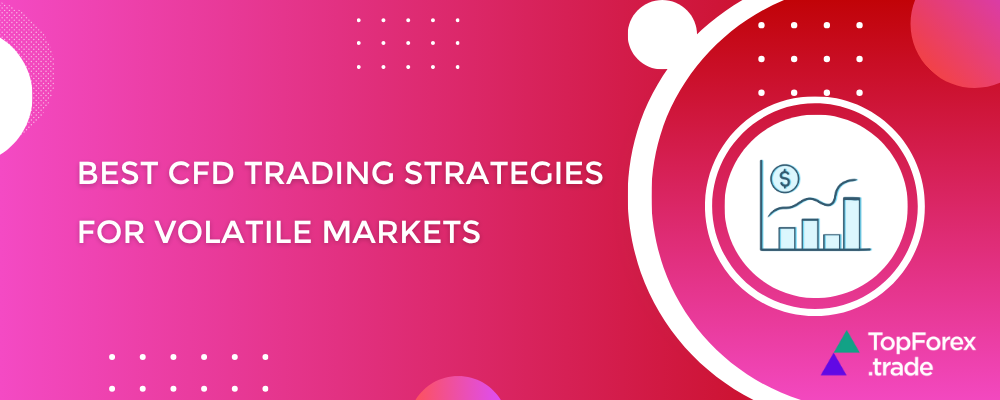5 best CFD strategies to trade volatile markets in 2025

Volatile markets can be both a trader’s dream and nightmare. While they offer high-profit potential, they also come with increased risk. Contracts for Difference (CFDs) allow traders to capitalize on price movements without owning the underlying asset, making them ideal for volatile conditions.
In this guide, we’ll explore the best CFD strategies for 2025 to help you navigate turbulent markets effectively, along with real-world examples.
Breakout trading

What it is: Breakout trading involves entering a trade when the price moves beyond a defined support or resistance level.
Why it works in volatility: Volatile markets often experience sharp price movements, leading to strong breakouts.
Example:
- Asset: Bitcoin (BTC/USD)
- Scenario: BTC consolidates between $60,000 (support) and $65,000 (resistance).
- Action: If BTC breaks above $65,000 with high volume, traders go long, expecting further upside.
Key tip: Use stop-loss orders below the breakout point to manage risk.
Scalping

What it is: Scalping involves making multiple small trades to profit from tiny price movements.
Why it works in volatility: High volatility increases liquidity and price fluctuations, allowing scalpers to enter and exit quickly.
Example:
- Asset: EUR/USD
- Scenario: The pair moves rapidly between 1.0850 and 1.0870 due to economic news.
- Action: A scalper buys at 1.0850 and sells at 1.0865 repeatedly within minutes.
Key tip: Use tight spreads and low-latency execution brokers.
Hedging with CFDs

What it is: Hedging involves opening offsetting positions to reduce risk.
Why it works in volatility: If you hold a long-term stock position but expect short-term downside, you can short the same asset via CFDs.
Example:
- Asset: Tesla (TSLA)
- Scenario: You own Tesla shares but fear a market correction.
- Action: Open a short CFD position on TSLA to offset potential losses.
Key tip: Monitor correlation risk – ensure the CFD and underlying asset move similarly.
News-based trading

What it is: Trading based on economic events, earnings reports, or geopolitical news.
Why it works in volatility: Major news triggers rapid price movements.
Example:
- Event: Federal Reserve interest rate decision
- Asset: Gold (XAU/USD)
- Action: If the Fed signals rate cuts, traders buy gold CFDs, expecting a rally.
Key tip: Use an economic calendar and trade immediately after news releases.
Mean reversion strategy

What it is: Betting that extreme price movements will reverse to the average.
More about: Forex mean reversion explained: strategies, indicators, and Top brokers
Why it works in volatility: Overextended trends often pull back.
Example:
- Asset: NASDAQ 100 Index (NAS100)
- Scenario: After a sharp 3% drop, RSI shows oversold conditions.
- Action: Buy CFDs expecting a bounce.
Key tip: Combine with indicators like Bollinger Bands or RSI for confirmation.
Top 5 FX and CFD brokers for 2025
🎯 Pro tip: Use demo accounts to test trading strategies risk-free before committing capital.
Choosing the right broker is crucial if you’re looking to trade CFDs in volatile markets. Here are the best brokers for 2025:
BlackBull Markets
- Regulation: FMA (New Zealand)
- Features: Tight spreads, ECN execution, MetaTrader 4/5
- Best for: Scalpers and professional traders
XTB
- Regulation: FCA, CySEC, KNF
- Features: Low fees, advanced xStation platform, free educational resources
- Best for: Beginners and intermediate traders
eToro
- Regulation: FCA, CySEC, ASIC
- Features: Copy trading, social trading, user-friendly interface
- Best for: Social traders and long-term investors
Risk disclaimer: eToro is a multi-asset platform which offers both investing in stocks and cryptoassets, as well as trading CFDs.
CFDs are complex instruments and come with a high risk of losing money rapidly due to leverage. 61% of retail investor accounts lose money when trading CFDs with this provider. You should consider whether you understand how CFDs work, and whether you can afford to take the high risk of losing your money.
This communication is intended for information and educational purposes only and should not be considered investment advice or investment recommendation. Past performance is not an indication of future results.
Copy Trading does not amount to investment advice. The value of your investments may go up or down. Your capital is at risk.
Don’t invest unless you’re prepared to lose all the money you invest. This is a high-risk investment and you should not expect to be protected if something goes wrong. Take 2 mins to learn more.
eToro USA LLC does not offer CFDs and makes no representation and assumes no liability as to the accuracy or completeness of the content of this publication, which has been prepared by our partner utilizing publicly available non-entity specific information about eToro.
AvaTrade
- Regulation: Central Bank of Ireland, ASIC, FSCA
- Features: Automated trading (DupliTrade), wide asset selection
- Best for: Algorithmic traders
Exness
- Regulation: FCA, CySEC, FSCA
- Features: Ultra-low spreads, instant withdrawals
- Best for: High-frequency traders
Related articles:
Best CFD strategies for volatile markets - FAQ